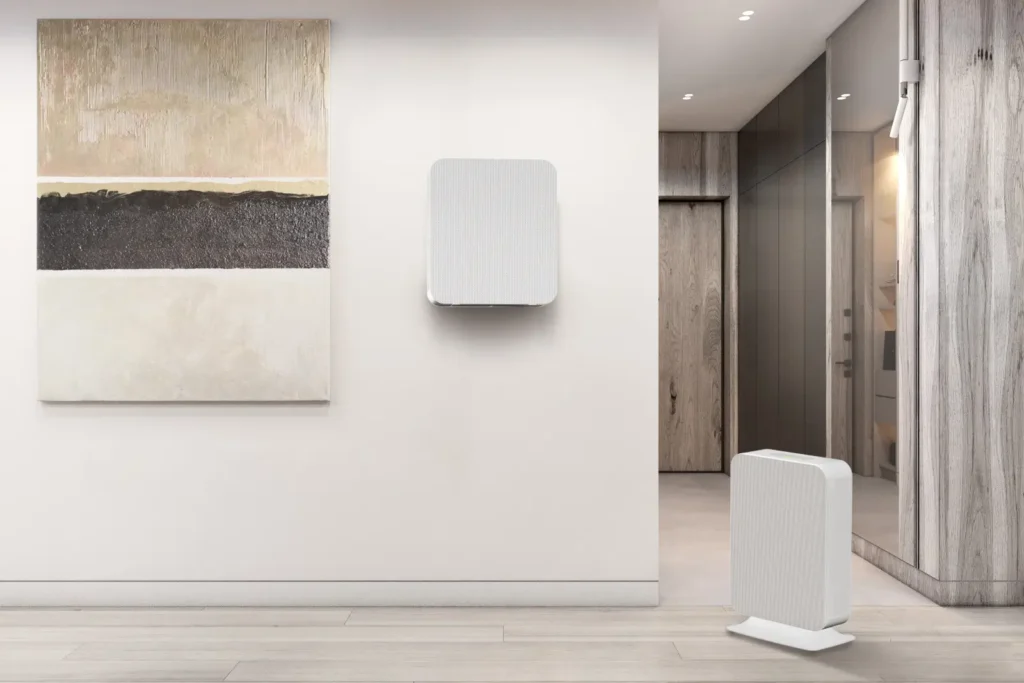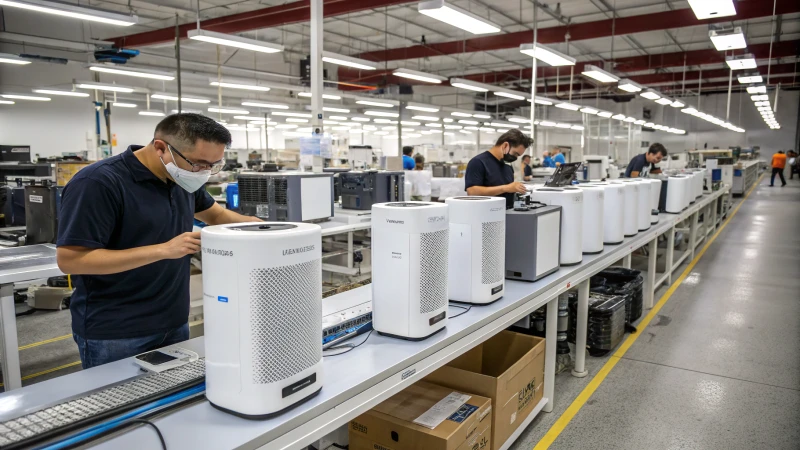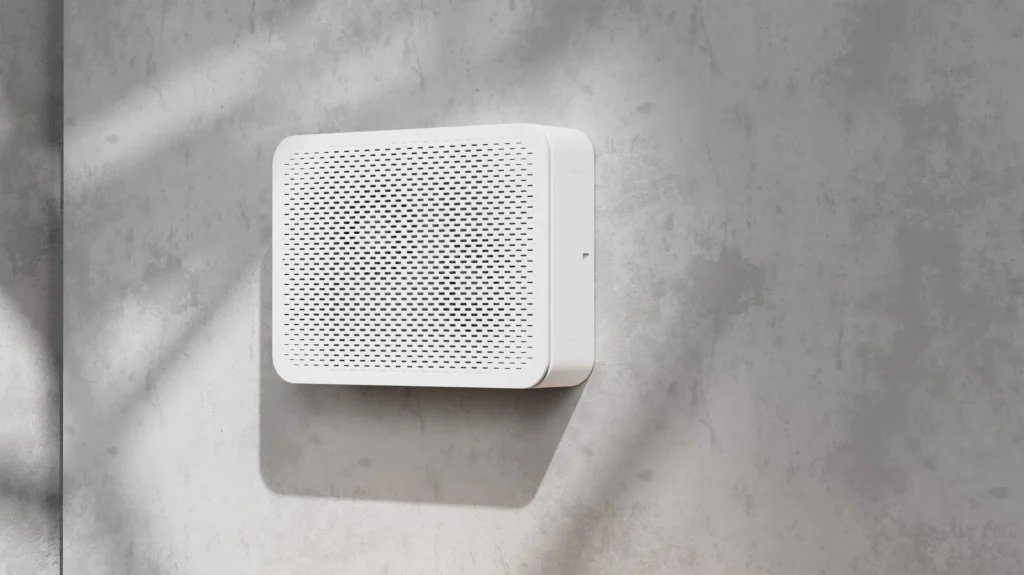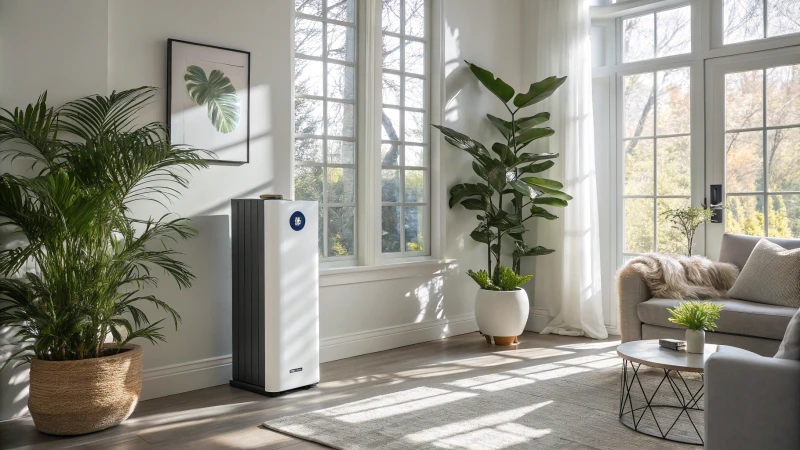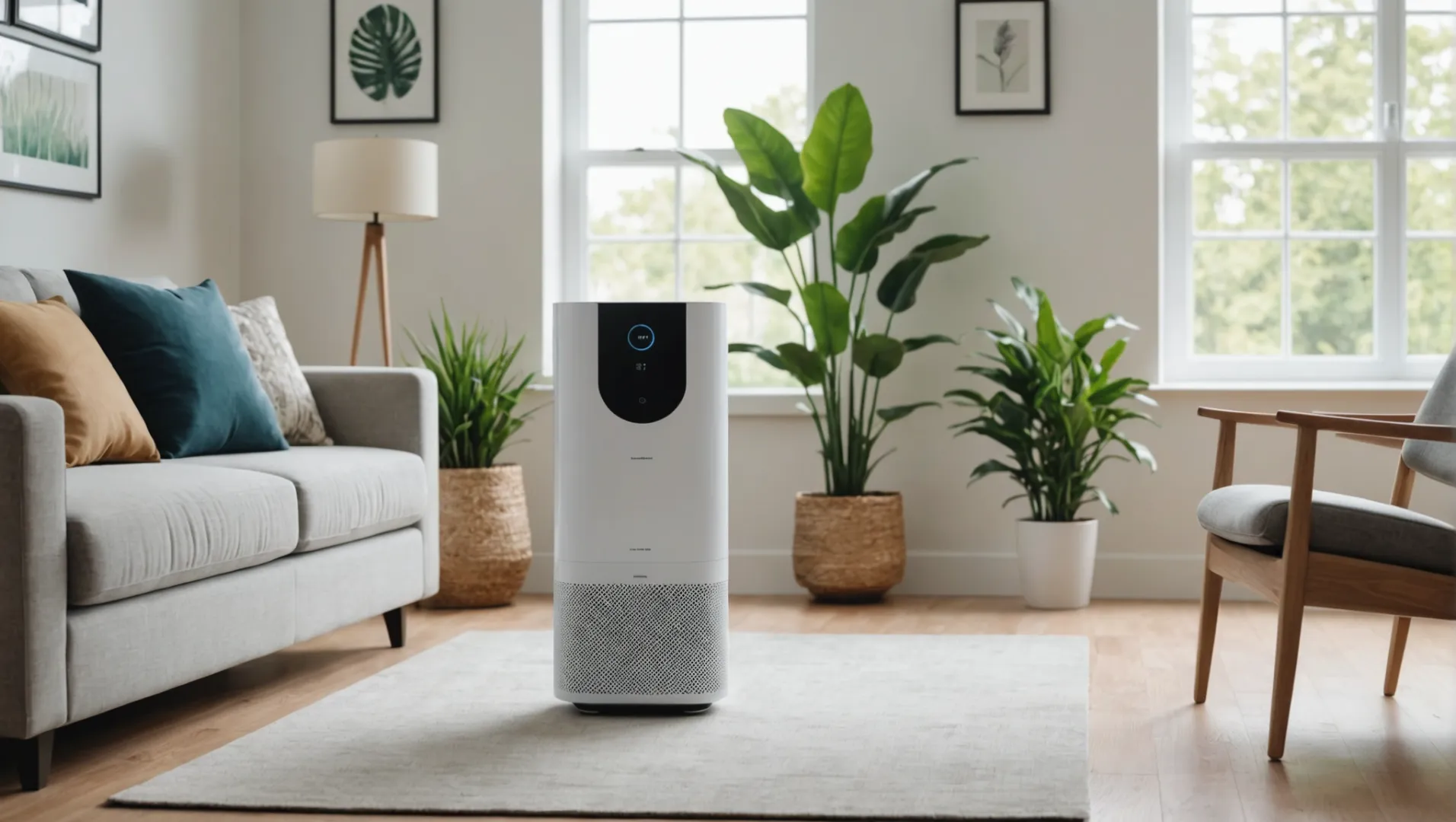
Dans un monde où notre santé est plus que jamais liée à la qualité de l'air, il est devenu essentiel de savoir comment s'assurer que mon purificateur d'air répond aux normes reconnues.
Pour que votre purificateur d'air soit conforme aux AHAM se concentrent sur l'obtention d'un taux de distribution d'air pur (CADR) en fonction de la taille de votre pièce et de respecter la "règle des 2/3". Cela garantit une filtration efficace des polluants et une qualité d'air optimale.
En saisissant CADR et la "règle des 2/3" constituent un excellent point de départ, mais il y a beaucoup plus à apprendre pour s'assurer que votre purificateur d'air est conforme aux normes de l'UE. AHAM et les normes qui s'y rapportent. Parcourons ensemble ce guide détaillé, où nous découvrirons les certifications, les réglementations émergentes et des conseils pratiques pour prendre des décisions en connaissance de cause.
La "règle des 2/3" de l'AHAM garantit une efficacité optimale des purificateurs d'air.Vrai
La "règle des 2/3" consiste à adapter la capacité du purificateur à la taille de la pièce pour plus d'efficacité.
Qu'est-ce que la AHAM La "règle des 2/3" et son incidence sur les performances des purificateurs d'air
Les AHAM La "règle des 2/3" est une ligne directrice essentielle pour l'efficacité des purificateurs d'air, qui a un impact significatif sur la qualité de l'air intérieur.
Les AHAM La "règle des 2/3" stipule que le taux de livraison d'air pur (CADR) d'un purificateur d'air doit être au moins égale aux deux tiers de la superficie de la pièce en pieds carrés. Cette règle garantit une purification efficace de l'air en adaptant la capacité du purificateur à la taille de la pièce.
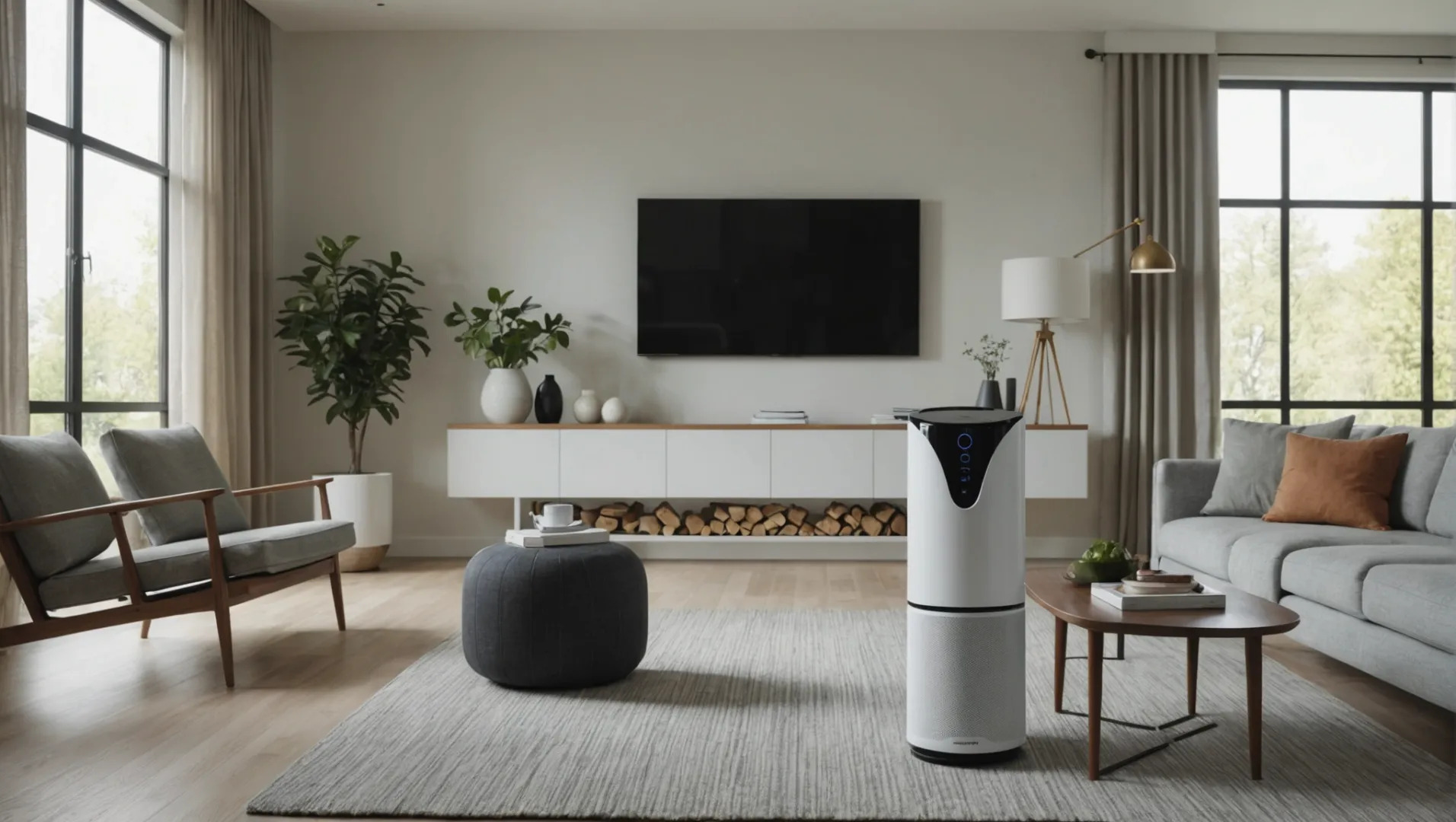
Comprendre la AHAM Règle des 2/3
Les Association des fabricants d'appareils ménagers (AHAM)1 a établi la "règle des 2/3" comme référence pour déterminer l'efficacité d'un purificateur d'air dans un espace donné. Essentiellement, la règle des CADR doit correspondre à au moins deux tiers de la taille de votre pièce en pieds carrés. Par exemple, si vous avez une pièce de 150 pieds carrés, votre purificateur d'air doit avoir une puissance de CADR d'au moins 100. Cette ligne directrice est cruciale car elle garantit que le purificateur d'air peut réduire efficacement les particules en suspension dans l'air et maintenir une qualité optimale de l'air intérieur.
La science derrière CADR et son impact
Le taux de distribution d'air pur (CADR) mesure le volume d'air filtré fourni par un purificateur d'air. Il reflète la capacité du purificateur à éliminer des polluants spécifiques, tels que la fumée, le pollen et la poussière, de l'environnement intérieur. En adhérant à la "règle des 2/3", les fabricants peuvent s'assurer que leurs produits sont à la fois efficaces et fiables, ce qui permet aux consommateurs d'avoir confiance dans leurs capacités de purification de l'air.
CADR Les notations et leur importance
CADR sont données pour trois polluants courants :
| Polluant | Typique CADR Nécessaire pour un retrait efficace |
|---|---|
| Fumée | Haut CADR est essentielle en raison de la petite taille des particules. |
| Pollen | Modéré CADR car le pollen est plus gros et moins dense. |
| Poussière | Semblable au pollen, mais peut nécessiter une dose légèrement plus élevée de CADR. |
En comprenant ces classifications et leur importance, les consommateurs peuvent choisir les purificateurs d'air qui répondent le mieux à leurs besoins, en veillant à ce que leurs environnements de vie restent sûrs et sains.
L'importance du respect des normes
Conformité avec AHAM garantit non seulement la qualité et la performance, mais s'aligne également sur des réglementations en constante évolution telles que le Energy Star et DOE certifications2. Ces certifications indiquent qu'un purificateur d'air est économe en énergie et qu'il répond à des directives gouvernementales strictes, offrant ainsi une plus grande tranquillité d'esprit aux consommateurs.
Au fur et à mesure de l'apparition de nouvelles réglementations, telles que la prochaine DOE En raison de l'exigence de conformité de l'UE en 2024, il est d'autant plus important de comprendre comment maintenir ces normes. Il est important de rester informé des changements législatifs susceptibles d'affecter la conception et la conformité des produits.
En fin de compte, la compréhension et l'application de la AHAM La règle des 2/3 permet aux fabricants et aux consommateurs de prendre des décisions éclairées sur les solutions de purification de l'air, contribuant ainsi à une meilleure qualité de l'air et à des espaces de vie plus sains.
La "règle des 2/3" de l'AHAM exige que le CADR soit égal aux deux tiers de la taille de la pièce.Vrai
Cela garantit que le purificateur d'air nettoie efficacement l'air de la pièce.
La "règle des 2/3" n'a rien à voir avec l'efficacité des purificateurs d'air.Faux
La règle a une incidence directe sur la qualité de l'épuration de l'air par les purificateurs d'air.
Pourquoi la CADR Important pour la conformité des purificateurs d'air ?
Comprendre CADR est essentiel pour garantir que votre purificateur d'air purifie efficacement l'air intérieur.
CADRLe taux de distribution d'air pur, ou taux de distribution d'air pur, mesure l'efficacité d'un purificateur d'air à éliminer les polluants. Il est essentiel pour se conformer à des normes telles que celles établies par l'Association of Home Appliance Manufacturers (AHAM), en veillant à ce que les dispositifs soient efficaces et répondent aux attentes des consommateurs.
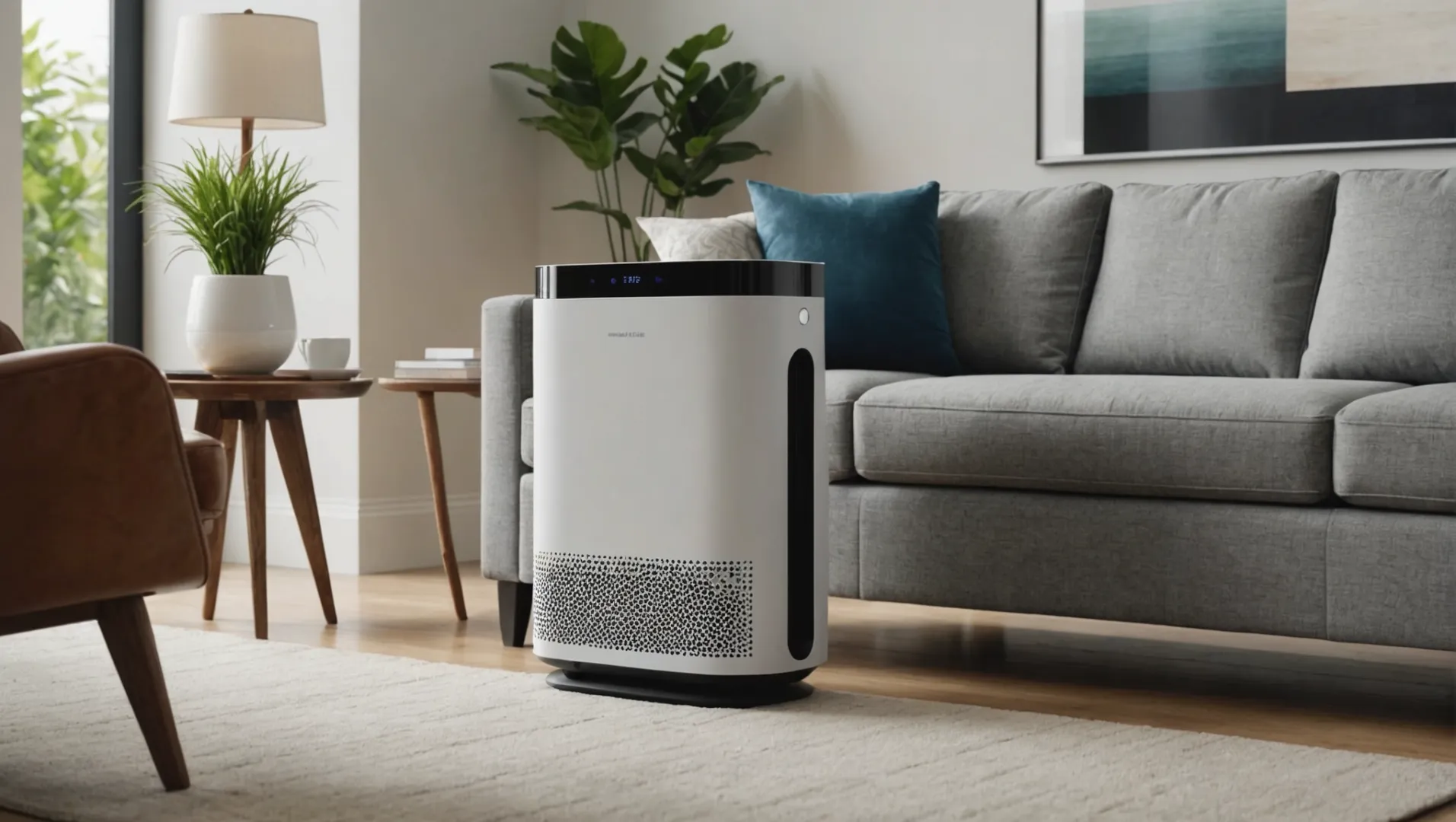
Le rôle des CADR dans la qualité de l'air
Le taux de distribution d'air pur (CADR) est une mesure essentielle qui indique la vitesse à laquelle un purificateur d'air peut éliminer les particules de l'air. Il est exprimé en pieds cubes par minute (PCM) et représente le volume d'air filtré produit. Plus élevé CADR Les chiffres signifient une élimination plus rapide des polluants, ce qui améliore la qualité de l'air. qualité de l'air3 de manière significative.
CADR est essentiel non seulement pour évaluer les performances d'un purificateur d'air, mais aussi pour s'assurer qu'il répond aux normes de l'industrie. Les AHAM utilise CADR pour tester et vérifier les purificateurs d'air, afin de fournir aux consommateurs des informations fiables.
Réunion AHAM Normes
Pour se conformer à AHAM Les fabricants doivent s'assurer que leurs produits atteignent un certain niveau de qualité. CADR en fonction de la taille de la pièce. La "règle des 2/3" suggère qu'un purificateur d'air doit avoir une capacité de CADR équivalent à au moins deux tiers de la superficie de la pièce en pieds carrés. Par exemple, dans une pièce de 150 pieds carrés, les CADR doit être d'au moins 100 CFM.
| Taille de la pièce (m²) | Minimum CADR (CFM) |
|---|---|
| 100 | 67 |
| 150 | 100 |
| 200 | 133 |
Cette conformité garantit que le purificateur peut éliminer efficacement les polluants tels que la fumée, le pollen et la poussière, afin de maintenir un environnement intérieur sain.
CADR et règlements émergents
Au-delà AHAM les nouvelles réglementations telles que AHARE 241 se concentrent sur le maintien d'un minimum de 6 renouvellements d'air par heure (ACH). Cette prochaine mise en conformité pourrait rendre CADR encore plus critique pour les espaces commerciaux, où le maintien d'une qualité d'air optimale est crucial pour la santé et la productivité.
Les fabricants se concentrent sur Energy Star4 les certifications trouveront également CADR car elle a un impact sur l'efficacité énergétique des purificateurs. À partir de 2024, tous les purificateurs d'air commercialisés aux États-Unis devront être conformes aux normes du ministère de l'énergie (DOE), soulignant ainsi l'importance de l CADR pour la conformité et la compétitivité du marché.
Un CADR plus élevé signifie une élimination plus rapide des polluants.Vrai
Le CADR mesure la vitesse à laquelle un purificateur d'air nettoie l'air, des valeurs élevées indiquant une élimination plus rapide.
Les normes AHAM exigent que le CADR soit égal à la taille de la pièce en pieds carrés.Faux
Les normes AHAM exigent que le CADR soit égal aux deux tiers de la surface de la pièce en pieds carrés.
Comment les labels Energy Star et DOE Les certifications ont-elles un impact sur votre purificateur d'air ?
Dans le monde actuel, soucieux de l'environnement, il est essentiel de comprendre les certifications des purificateurs d'air pour faire des choix durables.
Energy Star et DOE garantissent que les purificateurs d'air sont économes en énergie et conformes aux normes américaines. Ces certifications permettent non seulement de réduire les coûts d'électricité, mais aussi de garantir la conformité avec les réglementations à venir, ce qui fait de votre purificateur d'air un investissement plus judicieux.
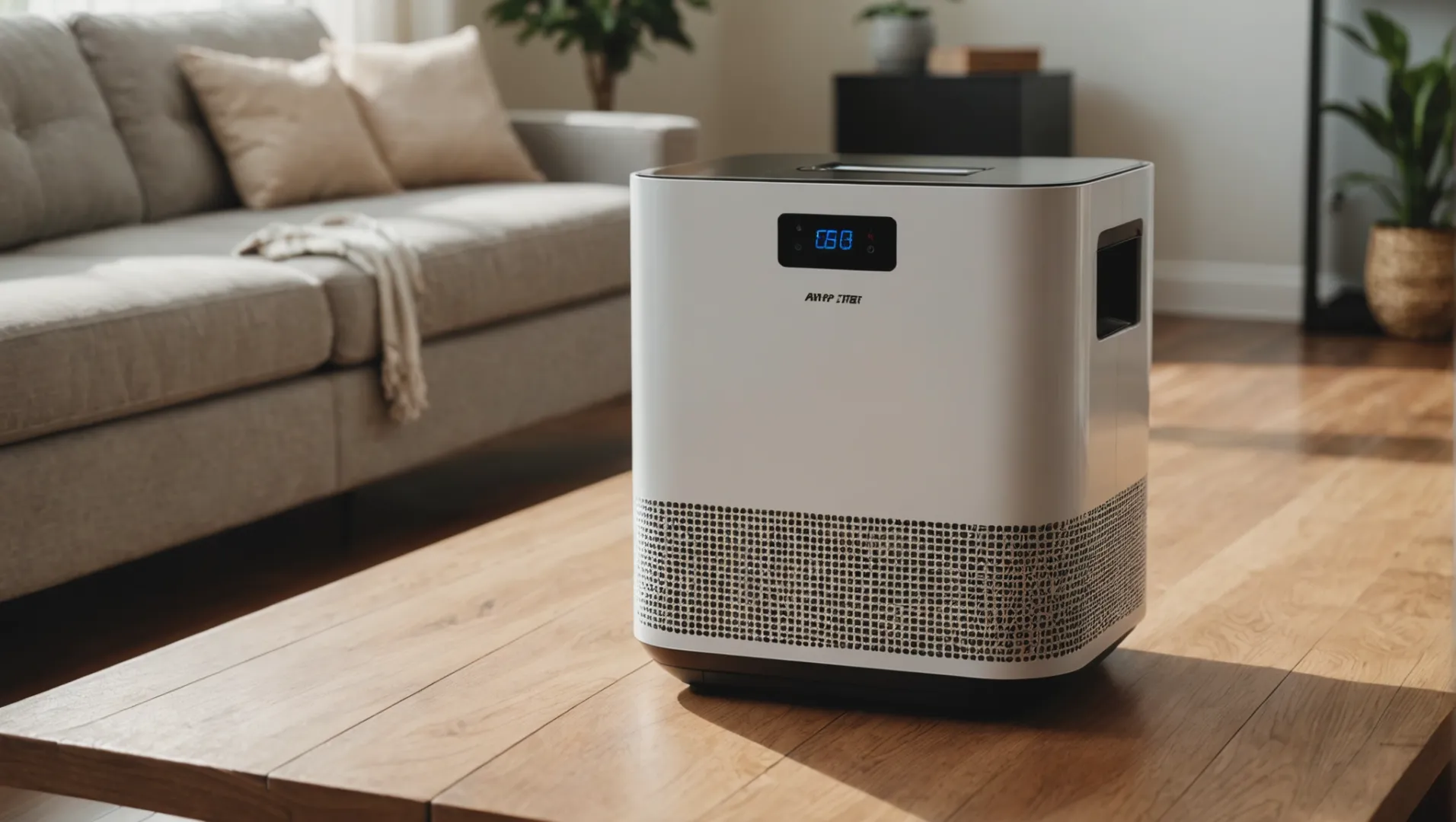
Comprendre la certification Energy Star
Energy Star est un symbole de confiance pour l'efficacité énergétique. Il signifie qu'un appareil, tel qu'un purificateur d'air, respecte ou dépasse des normes spécifiques de performance énergétique. Dans le cas d'un purificateur d'air, cela signifie qu'il fonctionne efficacement sans compromettre ses performances. Cette certification peut permettre de réaliser d'importantes économies sur les factures d'énergie, en particulier si l'appareil fonctionne en continu dans des environnements où la qualité de l'air est un sujet de préoccupation.
En choisissant un Purificateur d'air certifié Energy Star5Les consommateurs sont assurés d'une réduction de la consommation d'énergie, ce qui est conforme aux objectifs de développement durable et réduit leur empreinte carbone.
DOE Certification : Un must-have à partir de 2024
Le Département de l'énergie (DOE) pour les purificateurs d'air sera obligatoire à partir de 2024, établissant ainsi une référence en matière d'efficacité énergétique pour l'ensemble du secteur. Cette certification garantit que tous les nouveaux purificateurs d'air entrant sur le marché américain répondent à des normes d'efficacité minimales, ce qui permet aux consommateurs d'éviter les produits qui, autrement, consommeraient plus d'énergie.
DOE-Les produits certifiés sont testés dans des conditions rigoureuses, ce qui permet de s'assurer qu'ils sont très performants et qu'ils consomment peu d'énergie. Cet aspect devient crucial à mesure que les préoccupations environnementales augmentent et que les consommateurs exigent des produits plus durables.
L'impact sur les choix des consommateurs
Grâce à ces certifications, les consommateurs peuvent prendre des décisions d'achat en connaissance de cause. Les économies potentielles sur les factures d'électricité grâce à la réduction de la consommation d'énergie peuvent être considérables. De plus, avec les DOE devenant obligatoire, l'achat de modèles non certifiés pourrait bientôt être hors de question.
Pour les fabricants, s'aligner sur les Energy Star et DOE normes6 renforce non seulement la réputation de la marque, mais élargit également les débouchés commerciaux en répondant aux exigences réglementaires.
Implications pour l'industrie
Ces certifications favorisent également les avancées technologiques au sein de l'industrie. Les fabricants sont contraints d'innover, en se concentrant sur des conceptions écoénergétiques qui ne compromettent pas les performances. En conséquence, nous pouvons nous attendre à ce que les purificateurs d'air deviennent plus sophistiqués, offrant des fonctions améliorées tout en consommant moins d'énergie.
En conclusion, bien que ces certifications semblent d'abord être des labels, leur impact est profond : elles façonnent le comportement des consommateurs, influencent les processus de fabrication et, en fin de compte, sont bénéfiques pour l'environnement.
La certification Energy Star permet de réduire les factures d'énergie.Vrai
Les produits certifiés Energy Star sont conçus pour être économes en énergie et réduire les coûts d'électricité.
La certification DOE est facultative pour les purificateurs d'air en 2024.Faux
La certification DOE sera obligatoire à partir de 2024 pour tous les purificateurs d'air aux États-Unis.
Qu'est-ce que la conformité AHARE 241 et pourquoi devez-vous vous en préoccuper ?
La mise en conformité avec l'AHARE 241 représente un tournant dans les normes de purification de l'air, impactant à la fois les fabricants et les consommateurs.
La norme AHARE 241 exige que les purificateurs d'air assurent un minimum de six renouvellements d'air par heure (ACH) dans les pièces et les espaces commerciaux. Cette norme est essentielle au maintien d'une qualité optimale de l'air intérieur et devrait constituer un facteur important sur le marché des purificateurs d'air, en particulier aux États-Unis, après 2024.
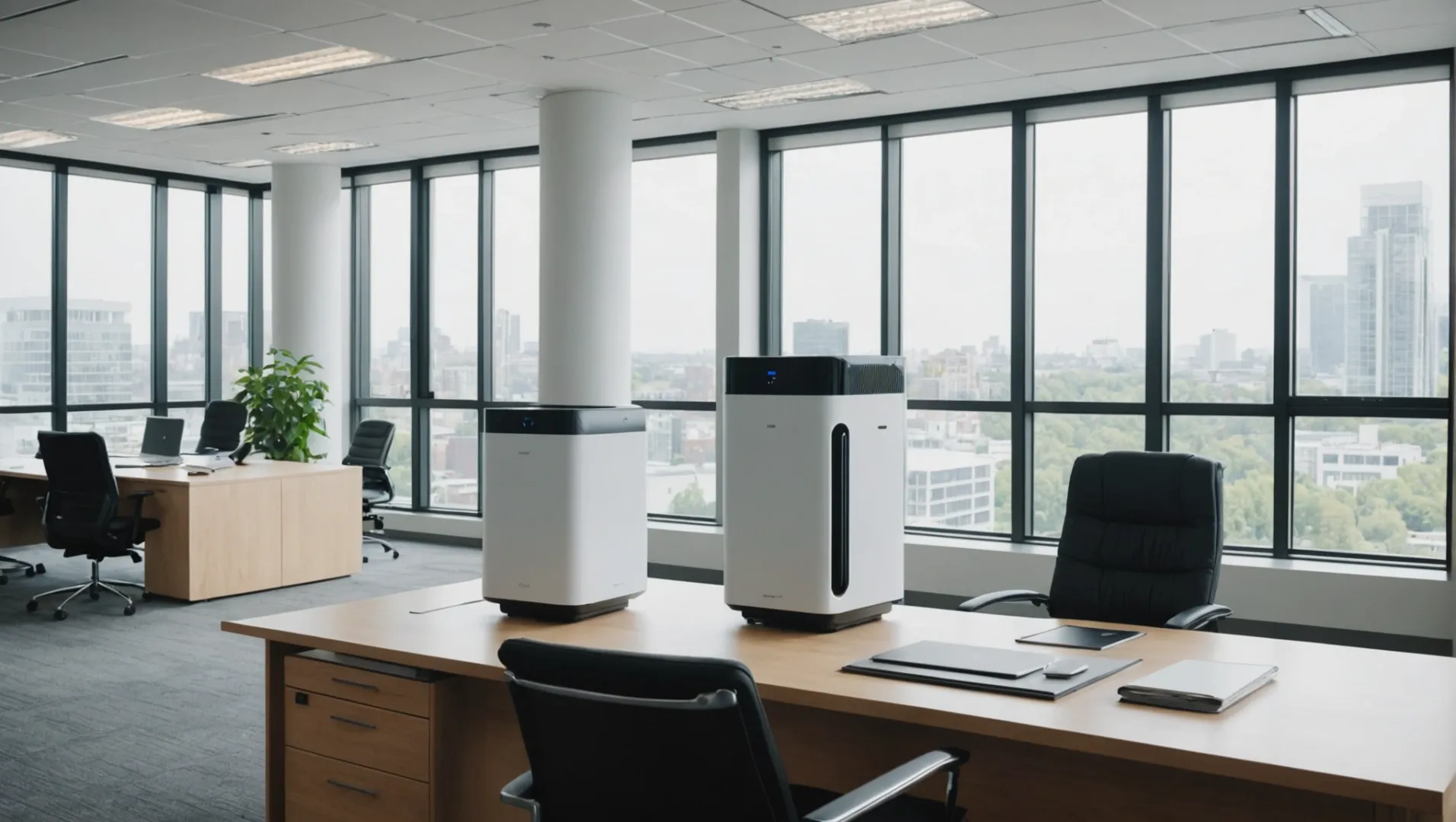
Comprendre la conformité à AHARE 241
La conformité à la norme AHARE 241 est une norme émergente qui vise à révolutionner la façon dont les purificateurs d'air sont conçus et utilisés dans divers environnements. L'exigence centrale de cette conformité est d'atteindre au moins six renouvellements d'air par heure (ACH) dans un espace donné, y compris les pièces résidentielles, les bâtiments commerciaux et les systèmes de CVC. Ce critère garantit que l'air dans ces espaces est constamment rafraîchi, ce qui réduit considérablement la concentration de polluants en suspension dans l'air.
L'introduction de cette norme intervient à un moment où la sensibilisation à la qualité de l'air intérieur n'a jamais été aussi forte. La pandémie de COVID-19 a mis en évidence l'importance d'un air intérieur propre, incitant les organismes de réglementation à exiger des normes plus strictes. En conséquence, la conformité à la norme AHARE 241 deviendra probablement un facteur critique pour les fabricants et les consommateurs.
Implications pour les fabricants et les consommateurs
Pour les fabricants, s'aligner sur la conformité AHARE 241 signifie investir dans la recherche et le développement afin de créer des purificateurs d'air plus efficaces, capables de répondre aux six critères suivants ACH de l'exigence d'efficacité. Il peut s'agir de revoir la conception des modèles existants ou de développer de nouvelles technologies qui améliorent le flux d'air et les capacités de filtration.
Pour les consommateurs, en particulier ceux des États-Unis, la conformité à la norme AHARE 241 deviendra bientôt un élément clé lors de l'achat de purificateurs d'air. La nouvelle législation étant attendue après 2024, les consommateurs devraient rechercher des produits qui non seulement répondent à cette norme, mais qui peuvent également se prévaloir de certifications comme Energy Star et DOE pour l'efficacité énergétique.
L'avenir de la purification de l'air
L'évolution vers la conformité à l'AHARE 241 est le signe d'une tendance plus large dans l'industrie de la purification de l'air. La demande d'environnements intérieurs plus propres s'accroît, tout comme les possibilités d'innovation dans les technologies de purification de l'air. Purificateurs d'air commerciaux7 devraient connaître une croissance significative, sous l'effet de la nouvelle législation et de l'importance accrue accordée au maintien d'environnements intérieurs sûrs et sains.
En résumé, la compréhension et l'adoption de la conformité AHARE 241 sont essentielles pour toute personne impliquée dans le marché de la purification de l'air. Qu'il s'agisse d'un fabricant souhaitant rester à la pointe de la réglementation ou d'un consommateur cherchant à garantir une qualité optimale de l'air intérieur, cette conformité offre une voie claire vers la réalisation de ces objectifs.
AHARE 241 exige six renouvellements d'air par heure.Vrai
La norme exige que les purificateurs d'air atteignent six ACH dans n'importe quel espace.
Après 2024, AHARE 241 n'affectera pas les consommateurs américains.Faux
Après 2024, AHARE 241 jouera un rôle crucial dans le choix des purificateurs d'air aux États-Unis.
Conclusion
Naviguer AHAM est essentielle pour garantir une purification efficace de l'air. En comprenant CADRGrâce aux certifications et aux normes émergentes, vous pouvez améliorer la qualité de l'air tout en gardant une longueur d'avance sur les réglementations. Investissez judicieusement dans votre santé et dans l'avenir de la purification de l'air.
-
Découvrez comment cette règle optimise les performances des purificateurs d'air.. : Suivez la règle des 2/3 de l'AHAM : vous voudrez toujours un appareil dont le CADR pour la fumée de tabac est au moins égal aux 2/3 de la surface de votre pièce. Par exemple, une pièce de 10 pieds x 12 pieds - 120 pieds carrés ... ↩
-
Découvrez comment ces certifications améliorent l'efficacité et la conformité.. : Les purificateurs d'air ambiant certifiés ENERGY STAR sont environ 25% plus économes en énergie que les modèles standard, ce qui permet aux consommateurs d'économiser environ 120 kWh/an et $18 par an sur ... ↩
-
Comprendre l'impact du CADR sur la qualité de l'air intérieur et l'efficacité des purificateurs.. : Le choix d'un purificateur d'air ayant un indice CADR élevé garantit qu'il nettoie efficacement l'air des polluants, tels que la poussière, le pollen, la fumée, ... ↩
-
En savoir plus sur les avantages et les exigences d'Energy Star pour les purificateurs d'air : Les purificateurs d'air ambiant certifiés ENERGY STAR sont environ 25% plus économes en énergie que les modèles standard, ce qui permet aux consommateurs d'économiser environ 120 kWh/an et $18 par an sur ... ↩
-
Découvrez pourquoi les modèles Energy Star sont rentables et respectueux de l'environnement .. : Les purificateurs d'air ambiant portant le label bleu ENERGY STAR sont 27% plus économes en énergie que les modèles standard et peuvent permettre aux consommateurs d'économiser plus de $130 sur la durée de vie ... ↩
-
Découvrez comment les certifications stimulent les débouchés commerciaux et la réputation de la marque.. : Les bâtiments certifiés ENERGY STAR consomment en moyenne 35 % d'énergie en moins que les bâtiments similaires au niveau national. Les économies réalisées peuvent être considérables. ↩
-
Découvrez les opportunités croissantes dans le domaine de la purification de l'air commercial après 2024 : Améliorer la qualité de l'air dans votre espace commercial - les purificateurs d'air peuvent éliminer la poussière, le pollen, les spores de moisissure, les virus, les bactéries, les composés organiques volatils et les odeurs ... ↩


